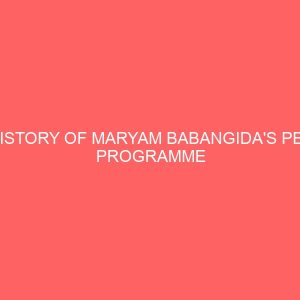Description
CHAPTER ONE
BACKGROUND OF THE STUDY
Oro is a town in Irepodun Local Government Area in Kwara State. It lies on the Ilorin-Lokoja highway, and is about fifty four kilometers West East of Ilorin, the State capital. Oro force within the middle belt region and a transition zone between the Northern savannah belt and the Southern tropical rainforest.
Oro has a fairly undulating topography with a sparse population which is widely spread over the landscape. Notable among the natural or physical landscape features in Oro includes the popular Olofian hill with a height of about 1,200ft above sea level.1 also there are some important rivery such as Osin which invariable is the largest with its source in Ila-Orangun: It manoeuvre its way through Omido, Agbonda, Esie, Iludun- Oro and Ilala, all in Irepodun L.G.A of Kwara State. Other notable rivers include Agba, Eleru and Ilaga.
With this background, it is important to note that in the historical development of the Oro communities (Ekumesan-Oro), the people of Okerimi-Oro have indeed played important roles that cannot be over emphasized.
To this end, the history of Oro generic towns will not be complete without mentioning the vital contributions made by one of her key component unit Okerimi-Oro. Today, Oro generic communities (Ekumesan-Oro) are a leading light among her contemporaries2 with all the units contributing their quotas towards this. However, it is important to list the nine generic towns which make up one entity known as the nine communities of Oro (Ekumesan-Oro).
AFIN-ORO
AGBEOLA-ORO
IDDO-ORO
IJUMO-ORO
IREBODE-ORO
ILUDUN-ORO
OKEOLA-ORO
OKERIMI-ORO
OTUN-ORO
Interestingly however, from the 19th century up till today, each of the component units of Oro has played and continues playing one significant role or the other towards her unity, progress and development. Okerimi-Oro is not an exception in this regard as earlier mentioned because the community is blessed with enormous human and materials resources such as, chief Awodiji and Oke-traco (Okerimi trading company) the contribution of these individuals make the town to be a role model and leading position among other Oro generic town. Her leadership role cannot be under estimated because it has contributed more than any other generic member of Oro town towards the political stabilization of the entity.
OBJECTIVES OF THE STUDY
This research work is mainly to focus on the contributions made by one of the component units of Oro land i.e. Okerimi-Oro, towards the progress and development of Oro generic towns.
This project work will bring to the focus of the general contributions made by the people of Okerimi-Oro to the present status of Oro kingdom. The work will be an addition to the few already done an a related topic by the indigenes of Okerimi-Oro, as well as reference point in addition to those published and unpublished materials, such as: Occupational Groups and Market in Oro group of villages, by Afolayan Adeola James, and Socio-Economic Development in Oro from 1900-20th century, by Oladimeji Jacob among others.
SCOPE OF THE STUDY
Okerimi-Oro is the major scope of the project due to her leading role in Oro kingdom in the 20th century which will be the area of concentration of the researcher. It will explain how Okerimi-Oro is a sleepy community with her sparse population among other component units. However, it will examine the various activities in which the said community engaged in such as farming and commercial activities.
More so, it will locate the infrastructural facilities the people of Okerimi-Oro are endowed with. It also important as it will examine the political leadership of Okerimi-Oro. Suffice it to say, the incumbent Oloro of Oro land is equally at Okerimi-Oro where he presides over the affairs of the Oro communities. All these together with other relevant issues will be examined in this project work.
Furthermore, the research work would help answer the following research questions:
The political contributions of Okerimi-Oro to the Oro kingdom
The roles played by Okerimi-Oro in the economic anticipation of Oro kingdom.
Roles played by Okerimi-Oro towards the educational development of Oro communities.
The roles Okerimi-Oro played towards the socio cultural development in Oro kingdom.
The religious contributions of Okerimi-Oro as well as their military contribution in the Oro kingdom. These will be given close appraisal together with the emergence of the structures and trend of changes in Okerimi-Oro.
RESEARCH METHODOLOGY AND PROBLEMS
In order to provide detailed and logical analysis of the issues, it becomes imperative for the researcher to rely heavily on both primary and secondary sources. This will make for better and clearer understanding of the research topic. 3
The study will start with the study of the existing literatures. This will be followed by the visit to the archives to obtain information through the preserved materials used by the administrations before and during the colonial periods. It would finally be concluded with field work by which oral data or information will be obtained.
However, chains of problems were encountered in the conduct of research on this work; the first being the inadequacy of secondary sources of direct relevance to this area. Also, existing documents such as short stories or articles in newspaper had a lot of misrepresentation on the actual events that took place. Examples of such were the articles in newspaper which were written during the market crisis in 1979 whose contents cannot be corroborated with oral accounts. For example, one of these documents gives the impression that Oro groups of villages came together in 1934 when Oro district was created4 but this assertion has no basis as the oral interview conducted and archival materials have shown.
Accordingly, oral data collection had its own inherent problems ranging from inconsistencies, sentimentality, myopic view points, subjectivity, exaggeration, inaccuracy and poor chronology. However, these problems were solved by juxtaposing oral information with other source of materials as well as adoption of holistic approach.
Another important factor that contributed to this problem was that of resistant informants whose opinion could be of immense benefit were not ready to speak to the researcher. There are also others who thought that this research was conducted as a result of being inspired by a set of people in the intra-community disputes that have for long infested this area. There were some whose schedule of activities was too demanding and these made them difficult to consult. The problem is peculiar to traditional leaders and business men who scarcely have time for interviews. But tis problem was solved by keeping appointment with them and this meant that the researcher had to travel several times.
LITERATURE REVIEW
There is no direct literature on this work. Apparently, the few works consulted do not directly relate to the area of the study, but they have provided a good background knowledge to the area of study. Among such work is ATANDA J.A. “An introduction to Yoruba history”5. This book gives an insight to the historical background of the Yoruba in which Oro group of village is part. It traces the origin of the Oro people to Ile-Ife and shows that the Igbomina in which Oro people are inclusive, recognized Ila-Orangun as their headquarters and Orangun as the supreme head of the group. This book has only shown that the Oro people have a Yoruba tradition with Ile-Ife. However, the book only gives brief historical information on Oro people.
In the same manner, another book titled “Revolution and Power Politics in Yoruba Land 1840-1893 by S.A. Akintoye”6 has been of tremendous use. Although this book too did not treat the history of Oro per say but it indeed shed some light into the kind of conditions faced by the Igbomina in which Oro was part, during the Yoruba inter-war years. It highlighted how the Oro people were passed from under one authority to the other as the revolution was passing supremacy from one Yoruba land to the other.
Unpublished work of Afolayan Adeola James titled “Occupational Groups and Market in Oro group of villages, 1900-1982”7also found to be academically useful to this research work. This work touched the economic aspect of Oro history. It also talked of traditional market system and its importance in Oro. The main area of relevance of this work is where the work treated the tax riot if 1933 and that of 1976 market crisis. However, the work failed to examine the political effect of such crisis since the work is mainly on economic history. Also, the work discussed the emigration of people of Oro, but this and other vital points were treated from economic perspectives.
Also available for this research work are pamphlets and magazines dealing specifically on Oro history. The political, social economic history of the people. But one main feature in these work is that they give rather flat accounts of events, therefore the constitute a problem which makes it highly difficult to periodise the facts they contain.
More so, some newspapers were also consulted to arrive at appreciable conclusion. Most of these deals with highlights on the political and economic pattern of Oro people especially after 19000, such as; Sunday Herald, January 29, 1984, “Oloro calls for co-operation”.8 This newspaper explained the effort of Oloro in uniting the people of Oro land. However, Nigerian Herald Tuesday July 6, 1976, “Oloro and his traditional chiefs”9 also been useful in locating Okerimi-Oro as an entity and her leadership structures. There also some articles that were written on Oro market which have been of great benefit. However, such information were used with caution since some of them were written during the market crisis in 1976, also oral source did not tall with the accounts given in some of the newspapers.
Additionally, Archival documents were also of immense benefit. Such documents include in particular, those which treated the 1933 tax riot and political aftermath. These are also those which gave accounts of the Oro district council particularly on the shifting of the market from Otun-Oro. It also discusses the political factors that came into operation in this issue. However, this document despite their usefulness, were treated with caution since a lot of the documents were written for official purpose either to be in favour of some particular actors in the events. It was also discovered that most of these documents however, for the fact that they were useful, they contained some information which actually misrepresented some participants in these events.
OROSCOPE10, published by Oro Federal Student Union. This magazine contains important information on the origin, climate, commercial activities and political organization of Oro.
Finally, in doing justification with the economic contribution of Okerimi-Oro, the unpublished work of Olawale Waheed Mustapha titled, “Some aspect of Economic History of Oro community 1900-1980”11. was found to be academically useful. This work touched the issue of Oro traders at home and in Diaspora. Although the work has been helpful to considerable extent, it failed to give an in depth study of the various economic development in Oro such as Agriculture, Transport, Communication, Banking, Health, Industries and the activities of Oro progressive union in the town.







